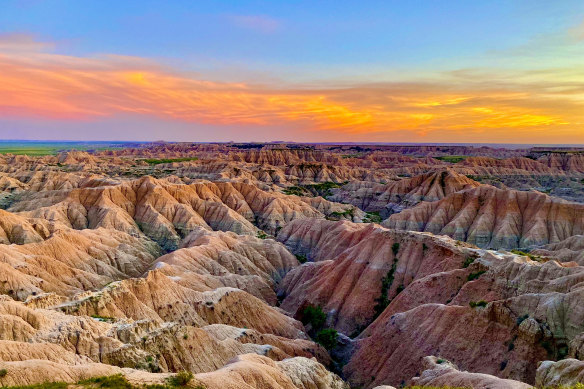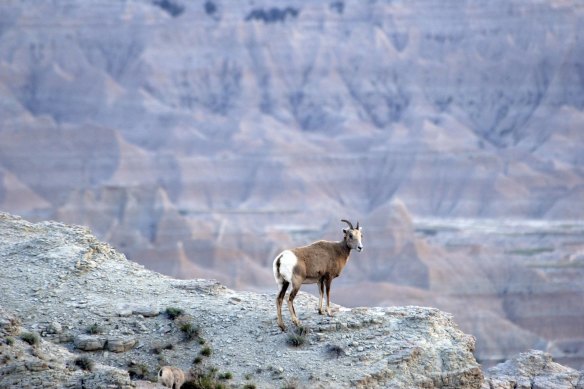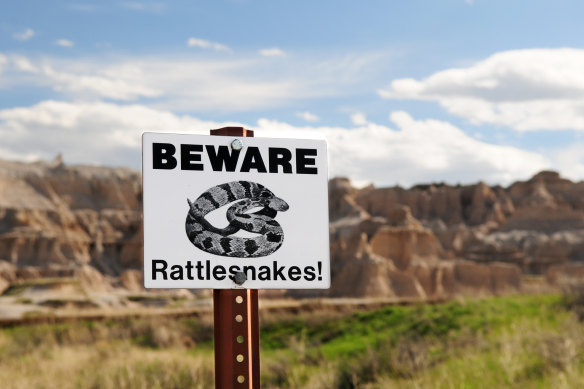America’s startling ‘geological hiccup’ is a candy-coloured wonderland
In theory, you could drive the 63-kilometre Badlands Loop Road in under an hour. Starting from the quirky town of Wall, South Dakota, the two-way paved highway squirms through the North Unit of Badlands National Park before rejoining Interstate 90 at the small hamlet of Cactus Flat (population 54).

Sunset in the Badlands National Park, South Dakota. Credit: Getty Images
In reality, I suspect few people manage it in less than five. Not because the road is choked with traffic or is particularly challenging to drive, but for the simple reason that it meanders through an otherworldly landscape of such arresting beauty that you’ll be repeatedly compelled to pull over just to gawp at its majesty.
The park itself is a lesson in contrasts. Around half of its 99,000 hectares is the US’ largest mixed-grass prairie – vast, windswept plains that, despite their bleakness, support a remarkable array of fauna, including bison, bighorn sheep, prairie dogs and over 200 species of birds. The other half is the Badlands, a geological wonderland of soaring buttes, plunging canyons and piercing spires.
And it’s this incongruity that is so startling. One minute you’re driving along an arrow-straight road through a sea of shimmering grass towards a featureless horizon; the next you’re assaulted by a Willy Wonka-ish eruption of candy-coloured hills, snaking gullies and striped cliff faces. Of course, there’s a tidy scientific explanation for it all – layers of rock deposited over the last 70 million years have been gradually eroded by rivers and rain during the last 500 millennia. That or Mother Nature let one of her kids go nuts with a giant tub of multicoloured Play-Doh.

Find a remarkable array of fauna, including bison, bighorn sheep and prairie dogs.Credit: Travel South Dakota
For the most part, the road hugs the Badlands Wall, a 100-kilometre-long escarpment that separates the upper and lower prairies. Along the way there are more than a dozen lookouts that provide head-spinning vistas over a remarkable variety of terrain – from intricate networks of ravines and gullies to hills so vibrantly coloured, they look like they’ve been the setting for one of those Indian festivals where everyone throws powdered paints at each other.
While the drive is unmissable, it’s also worth tackling one of the walking trails that crisscross this wondrous landscape. I choose the Medicine Root/Castle Trail loop, a 6.8-kilometre hike that starts with a scramble up a steep escarpment called Saddle Pass to reach the upper prairie. From there, I follow the Medicine Root Trail through assorted landscapes, from wildflower-peppered grass plains dotted with distinctive flat-topped mounds called sod tables to dramatic plunging canyons and elaborate rock “castles” that look like they’ve been sculpted by hand. Along the way, I pass a worrying number of signs stating – “Beware Rattlesnakes!”

Watch your step.Credit: iStock
At one point, I’m the only person in sight, and it strikes me how challenging it would be to eke out an existence here. Native Americans managed it for 12,000 years before Europeans arrived in the late 19th-century, but when the newcomers attempted to farm the land, most found the conditions too challenging and gave up.
It provides an insight into the park’s intriguing moniker, which it’s believed is derived from “mako sica”, the native Lakota people’s name for the region, which literally translates to “badlands”. With brutal winters, furnace-like summers and a chronic shortage of water, it certainly doesn’t scream retirement hotspot. The great irony of the Badlands is that in the grand scheme of things, it will be little more than a geological hiccup. It was only uncovered about 500,000 years ago and the soft sedimentary rock is eroding by more than two centimetres a year. All of which means that in another 500 millennia, it will no longer exist. So, in short, don’t hang around.
THE DETAILS
Visit
The Pinnacles Entrance to Badlands National Park is around 100 kilometres east of Rapid City, South Dakota, US. A seven-day vehicle entrance pass costs $US30 ($47). See nps.gov/badl
Tour
Adventure World’s “Dakotas Drive” self-drive tour includes 13 nights’ car rental and accommodation plus a detailed itinerary that contains the best of North and South Dakota. Departs daily from late-May to mid-September. From $3125 a person, twin share. See adventureworld.com.au
The writer was a guest of Brand USA (visittheusa.com.au), the Great American West (greatamericanwest.com.au) and South Dakota Department of Tourism (travelsouthdakota.com).
Sign up for the Traveller Deals newsletter
Get exclusive travel deals delivered straight to your inbox. Sign up now.